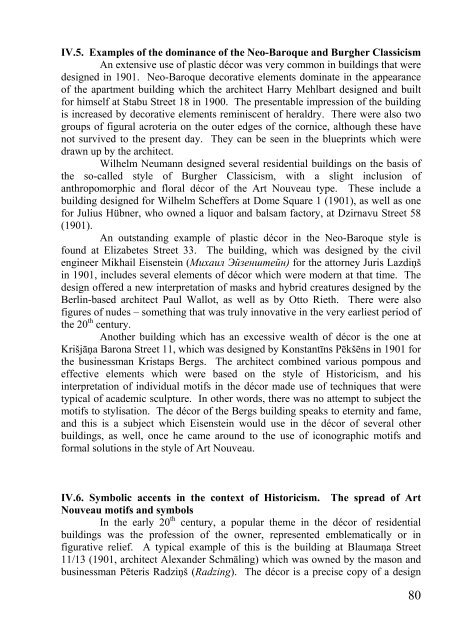SILVIJA GROSA JŪGENDSTILA PERIODA PLASTISKAIS UN ...
SILVIJA GROSA JŪGENDSTILA PERIODA PLASTISKAIS UN ...
SILVIJA GROSA JŪGENDSTILA PERIODA PLASTISKAIS UN ...
Create successful ePaper yourself
Turn your PDF publications into a flip-book with our unique Google optimized e-Paper software.
IV.5. Examples of the dominance of the Neo-Baroque and Burgher Classicism<br />
An extensive use of plastic décor was very common in buildings that were<br />
designed in 1901. Neo-Baroque decorative elements dominate in the appearance<br />
of the apartment building which the architect Harry Mehlbart designed and built<br />
for himself at Stabu Street 18 in 1900. The presentable impression of the building<br />
is increased by decorative elements reminiscent of heraldry. There were also two<br />
groups of figural acroteria on the outer edges of the cornice, although these have<br />
not survived to the present day. They can be seen in the blueprints which were<br />
drawn up by the architect.<br />
Wilhelm Neumann designed several residential buildings on the basis of<br />
the so-called style of Burgher Classicism, with a slight inclusion of<br />
anthropomorphic and floral décor of the Art Nouveau type. These include a<br />
building designed for Wilhelm Scheffers at Dome Square 1 (1901), as well as one<br />
for Julius Hübner, who owned a liquor and balsam factory, at Dzirnavu Street 58<br />
(1901).<br />
An outstanding example of plastic décor in the Neo-Baroque style is<br />
found at Elizabetes Street 33. The building, which was designed by the civil<br />
engineer Mikhail Eisenstein (Михаил Эйзенштейн) for the attorney Juris Lazdiņš<br />
in 1901, includes several elements of décor which were modern at that time. The<br />
design offered a new interpretation of masks and hybrid creatures designed by the<br />
Berlin-based architect Paul Wallot, as well as by Otto Rieth. There were also<br />
figures of nudes – something that was truly innovative in the very earliest period of<br />
the 20 th century.<br />
Another building which has an excessive wealth of décor is the one at<br />
Krišjāņa Barona Street 11, which was designed by Konstantīns Pēkšēns in 1901 for<br />
the businessman Kristaps Bergs. The architect combined various pompous and<br />
effective elements which were based on the style of Historicism, and his<br />
interpretation of individual motifs in the décor made use of techniques that were<br />
typical of academic sculpture. In other words, there was no attempt to subject the<br />
motifs to stylisation. The décor of the Bergs building speaks to eternity and fame,<br />
and this is a subject which Eisenstein would use in the décor of several other<br />
buildings, as well, once he came around to the use of iconographic motifs and<br />
formal solutions in the style of Art Nouveau.<br />
IV.6. Symbolic accents in the context of Historicism. The spread of Art<br />
Nouveau motifs and symbols<br />
In the early 20 th century, a popular theme in the décor of residential<br />
buildings was the profession of the owner, represented emblematically or in<br />
figurative relief. A typical example of this is the building at Blaumaņa Street<br />
11/13 (1901, architect Alexander Schmäling) which was owned by the mason and<br />
businessman Pēteris Radziņš (Radzing). The décor is a precise copy of a design<br />
80












